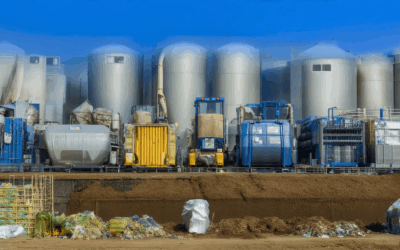With the world increasingly prioritizing sustainability and reducing its reliance on traditional energy sources, renewable waste technologies have emerged as a groundbreaking solution to manage waste effectively while generating energy. These innovative systems not only address the pressing need for waste management but also play a pivotal role in transitioning toward a greener, more sustainable future. By converting non-recyclable waste into a valuable resource, renewable waste technologies exemplify how science and innovation can solve complex global challenges.

Renewable Energy Technologies
Renewable energy technologies are innovative systems designed to harness energy from non-exhaustive sources such as sunlight, wind, water, and biological materials. These technologies aim to replace conventional fossil fuel-based energy production methods, thereby contributing to environmental sustainability and reducing greenhouse gas emissions.
- Solar Energy: Solar photovoltaics (PV) convert sunlight directly into electricity using semiconductors. Solar thermal systems heat water for residential and industrial use.
- Wind Energy: Wind turbines generate electricity by capturing kinetic energy from moving air, often installed offshore or on tall structures like buildings.
- Hydropower: Hydropower plants utilize the potential energy of flowing or falling water to produce electricity, with large-scale projects using dams and smaller systems employing micro-hydro technology.
- Bioenergy: Derived from organic matter, bioenergy is produced through anaerobic digestion of waste materials, generating biogas for energy.
- Geothermal Energy: Geothermal systems extract heat from the Earth’s interior, utilizing either shallow surface wells or deep drilling techniques for energy generation.
- Tidal and Wave Energy: Tidal barriers and ocean waves are converted into electricity using tidal turbines and wave energy converters, offering less common but promising alternatives.
- Energy Storage: Advanced battery technologies and seasonal storage solutions enable efficient utilization of renewable energy by storing surplus production for later demand.
- Smart Grids: Digitalized energy distribution systems optimize energy use by integrating renewable sources and enhancing grid efficiency through real-time monitoring and automation.
These technologies exemplify humanity’s commitment to transitioning towards cleaner, sustainable energy solutions, fostering innovation and environmental stewardship globally.
Technologies for Waste to Energy
Waste-to-energy (WtE) technologies convert non-recyclable waste into energy through thermal processes. Here are the primary methods used:
- Incineration
- High-temperature combustion of municipal solid waste (MSW) or refuse-derived fuel (RDF) in the presence of oxygen.
- Produces steam for electricity generation or heat for industrial use.
-
Types include mass-burn systems and fluidized-bed incinerators, which optimize energy recovery.
-
Anaerobic Digestion
- Decomposition of organic waste in oxygen-free environments to produce biogas (methane and carbon dioxide).
- Suitable for food scraps, sewage sludge, and agricultural waste.
-
Can be implemented in-vessel or in pond-based systems.
-
Gasification
- Partial oxidation of waste to produce synthesis gas (syngas), which can be used for electricity generation or converted into liquid fuels.
-
Efficient for a wide range of waste streams, including municipal and industrial waste.
-
Pyrolysis
- Thermal decomposition of carbon-rich waste in an inert atmosphere to produce biochar and syngas.
-
Ideal for bulky waste like tires, plastics, and biomass.
-
Biomass Digestion
- Controlled composting of organic waste to produce biogas.
-
Commonly practiced in Europe but less adopted globally due to regional differences.
-
Plasma Arc Technology
- Experimental method using ionized gas to breakdown waste into syngas at high temperatures.
- Promising but still under development.
These technologies vary in efficiency, cost, and scalability, making them suitable for different applications and regions. Pyrolysium supports innovative solutions like pyrolysis to transform waste into valuable resources, promoting sustainable living practices. For more information on waste-to-energy technologies, visit our website: Pyrolysium .

Example of Renewable Waste
Renewable waste refers to the conversion of discarded materials into usable forms of energy. Here are some examples:
- Biomass Conversion: Biomass, such as food scraps, wood waste, and agricultural residues, can be burned to generate electricity or heat. This process creates energy while reducing landfill waste.
- Composting: Kitchen scraps and yard waste can be composted to produce biogas through anaerobic digestion. This gas can be used for heating or generating electricity.
- Recycling Metals: Electronic waste, including old computers and smartphones, can be recycled to extract precious metals and reduce hazardous waste disposal.
- Plastic Recycling: Plastics can be recycled into raw materials for new products or converted into fuels, helping to reduce plastic pollution.
- Incineration: Waste materials are burned at high temperatures to produce energy, reducing the volume of waste and generating electricity.
These methods demonstrate how waste can be transformed into renewable energy, promoting sustainability and reducing environmental impact.
Learn more about sustainable waste solutions

What Are the New Waste to Energy Technologies?
Waste-to-energy technologies are evolving rapidly, offering innovative solutions to convert municipal solid waste (MSW), industrial waste, and organic waste into renewable energy. These technologies not only help reduce landfill dependency but also contribute to a circular economy by recovering valuable resources.
Key Waste-to-Energy Technologies
- Anaerobic Digestion: Breaks down organic waste in oxygen-free environments to produce biogas, a clean energy source. It is widely used in regions with high organic waste generation, such as food waste processing facilities.
- Gasification: Converts non-recyclable waste into synthesis gas (CO and H2) through controlled combustion. This process can produce syngas, which can be further refined into fuels or chemicals.
- Pyrolysis: Uses heat to decompose organic waste into biochar, carbon dioxide, and water vapor. Biochar can be reused as a soil amendment, making it a sustainable solution for waste management.
- Biochemical Methanization: Similar to anaerobic digestion, this process generates methane gas from organic waste, providing a renewable energy source for heating and electricity.
- Plasma Arc Gasification: A advanced version of gasification that uses plasma energy to break down waste into syngas, reducing the volume of waste significantly and producing less emissions compared to traditional methods.
Latest Innovations and Trends
Recent advancements in waste-to-energy technologies include:
- Advanced Sorting Systems: High-tech sorting equipment helps separate recyclables, organics, and residuals, optimizing the input for various conversion processes.
- Machine Learning Optimization: Predictive analytics and AI-driven systems enhance efficiency by optimizing operations and predicting maintenance needs.
- Integration with Renewables: Waste-to-energy plants are increasingly being paired with solar, wind, and battery storage systems to create hybrid energy systems.
- Policy Support and Partnerships: Governments worldwide are investing in R&D and incentives to promote these technologies, fostering collaboration between public and private sectors.
These technologies are transforming how we manage waste, turning it into a resource that supports sustainable development and energy security. Companies like Veolia , Covanta , and Waste Management Inc. are leading the charge in implementing these solutions globally.
Latest Innovations in Waste Management Technology
The waste management industry is rapidly evolving with cutting-edge technologies aimed at improving efficiency, reducing environmental impact, and promoting sustainability. Here are some of the most recent advancements:
- AI-Powered Route Optimization: Companies like Waste Management Inc. are leveraging AI and machine learning algorithms to optimize garbage truck routes, reducing fuel consumption and emissions by up to 15%. This technology also improves collection efficiency and lowers operational costs.
- Smart Waste Bins with IoT capabilities: Smart bins equipped with IoT sensors are being deployed globally. These bins monitor waste levels in real-time, enabling better scheduling of collections and reducing the frequency of manual checks. Examples include SmartBin and Pintark Bin Solutions .
- Circular Economy Platforms: Platforms like Loop and Refill are empowering businesses to take responsibility for their waste by transforming it into raw materials for others. This approach is gaining traction among major corporations such as Coca-Cola and Unilever .
- Biodegradable Packaging Solutions: Brands are increasingly adopting biodegradable and compostable packaging options. Companies like EcoPlastics and Biodec are leading the charge in creating packaging that decomposes quickly and doesn’t harm the environment.
- Advanced Sorting Systems: High-tech sorting systems using computer vision and AI are now being implemented in waste facilities. These systems can sort waste into categories with unprecedented accuracy, reducing contamination rates and improving overall processing efficiency. Tomra Sorting is a notable provider of such technologies.
- Recycling and Upcycling Technologies: Innovations in recycling technologies are making it possible to process harder-to-recycle materials like polystyrene and glass. Startups like Carbios and GlassCycle are developing advanced methods to transform these materials into reusable products.
- Anaerobic Digestion Systems: Companies such as Veolia and Xylem Technologies are expanding the use of anaerobic digestion systems to convert organic waste into biogas, a clean energy source. This approach significantly reduces methane emissions from landfills.
These technologies are not only enhancing operational efficiency but also driving toward a more sustainable future for waste management. By adopting these innovations, industries can reduce their environmental footprint while meeting growing consumer demands for eco-friendly solutions.

Alternative Energy Technologies
Alternative energy technologies encompass a variety of renewable energy sources that provide sustainable ways to generate electricity or heat. These technologies aim to reduce reliance on fossil fuels and minimize environmental impact.
- Solar Energy
- Photovoltaic cells convert sunlight directly into electricity.
- Solar thermal systems use sunlight to heat water for generating steam and electricity.
- Wind Energy
- Turbines harness kinetic energy from moving air to generate electricity.
- Onshore and offshore wind farms are common installations.
- Geothermal Energy
- Heat from the Earth’s core is used to generate electricity through steam turbines.
- Binary cycle systems enhance efficiency by using both low- and high-temperature reservoirs.
- Hydroelectric Energy
- Water flowing over dams or through turbines drives generators.
- Rivers and reservoirs are primary sources for hydropower.
- Tidal Energy
- Movement of tides and currents is converted into electricity.
- Barrages and underwater turbines are common tidal power technologies.
- Wave Energy
- Ocean waves are captured to generate electricity using buoys and underwater devices.
- Wave farms are increasingly popular along coastal regions.
- Bioenergy
- Biomass derived from organic matter is burned to generate energy.
- Biogas produced from waste materials is utilized for heating and electricity generation.
- Energy Storage
- Batteries store excess energy generated from renewable sources for later use.
- Compressed air and thermal storage systems are also emerging technologies.
These technologies offer diverse solutions to meet global energy demands sustainably. Each has unique advantages and applications, contributing to a cleaner and more efficient energy future.




0 Comments